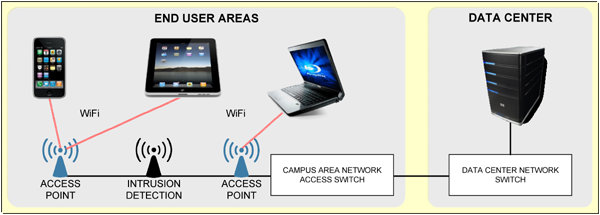Communications Infrastructure

The growth of mobile computing on the Internet has been accelerating; a trend that is expected to continue into the future, as organizations make increased use of mobile devices. The communications infrastructure is a major factor enabling today's mobile computing by providing continuous access to powerful applications and data bases hosted on servers in data centers.
On the Internet, wireless networks have been growing to provide increasing accommodations for wireless devices. Wireless access technologies including Wi-Fi, 4G, and LTE are being deployed to meet the needs of this highly competitive commercial market, to provide mobile devices access to the servers that power today's applications.
Access Architecture
The typical wireless access architecture depicted above illustrates how mobile computing can be implemented in a business environment. The access architecture is necessary to provide high bandwidth secure connections to corporate applications, data, and services. This architecture includes access points with integrated intrusion detection sensors to detect rogue devices. In this architecture, sessions are encrypted with centrally managed WiFi access points that connect to managed switches and routers for connection to business services and data.
Mobile Computing Architectures
Recognizing that mobile computing services depend heavily on back-end servers, it is important to understand the alternative architectural models that can be used, each of which has its respective advantages and disadvantages: Local Application Architecture, Web Browser Architecture, and Remote Desktop Architecture.
Local Application Architecture

The local application architecture is the simplest way to run installed applications natively on mobile devices. Data is accessed, stored, and processed by these applications which can interact with servers as needed to retrieve information. The limitations of this architecture include the security and capacity constraints involved in transferring data wirelessly, storing sensitive data on mobile devices, and processing data on the mobile device.
Web Browser Architecture

The web browser architecture allows the mobile user to access and work with massive data repositories, stored on web servers, leveraging the capacity, processing power, and security of these servers. The limitations of this architecture are the constraints of the mobile device's web browser, and caching exposures for sensitive data on the mobile device.
Remote Desktop Architecture

The remote desktop architecture uses a client connection application that provides a terminal session to either a terminal server or a virtual desktop session on a virtual desktop infrastructure (VDI). The advantage of this architecture is that the client session and application programs are actually running on the VDI servers in a secure data center, hosted on powerful multiprocessor servers, accessing data on high capacity storage systems, over high bandwidth data center networks. Only the screen display, keyboard inputs, and mouse controls traverse the wireless networks. Additionally, the user has access to the full graphical system user interface, desktop operating system, and applications running on the virtual desktop.







